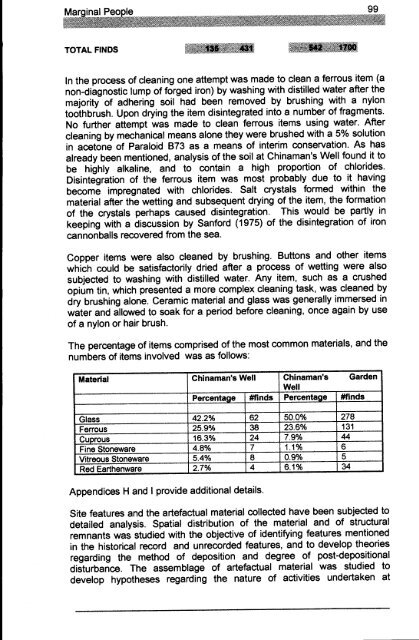Adec Preview Generated PDF File - The Sydney eScholarship ...
Adec Preview Generated PDF File - The Sydney eScholarship ...
Adec Preview Generated PDF File - The Sydney eScholarship ...
Create successful ePaper yourself
Turn your PDF publications into a flip-book with our unique Google optimized e-Paper software.
TOTAL FINDS<br />
In the process of cleaning one attempt was made to clean a ferrous item (a<br />
non-diagnostic lump of forged iron) by washing with distilled water after the<br />
majority of adhering soil had been removed by brushing with a nylon<br />
toothbrush. Upon drying the item disintegrated into a number of fragments.<br />
No further attempt was made to clean ferrous items using water. After<br />
cleaning by mechanical means alone they were brushed with a 5% solution<br />
in acetone of Paraloid B73 as a means of interim conservation. As has<br />
already been mentioned, analysis of the soil at Chinaman's Well found it to<br />
be highly alkaline, and to contain a high proportion of chlorides.<br />
Disintegration of the ferrous item was most probably due to it having<br />
become impregnated with chlorides. Salt crystals formed within the<br />
material after the wetting and subsequent drying of the item, the formation<br />
of the crystals perhaps caused disintegration. This would be partly in<br />
keeping with a discussion by Sanford (1975) of the disintegration of iron<br />
cannonballs recovered from the sea.<br />
Copper items were also cleaned by brushing. Buttons and other items<br />
which could be satisfactorily dried after a process of wetting were also<br />
subjected to washing with distilled water. Any item, such as a crushed<br />
opium tin, which presented a more complex cleaning task, was cleaned by<br />
dry brushing alone. Ceramic material and glass was generally immersed in<br />
water and allowed to soak for a period before cleaning, once again by use<br />
of a nylon or hair brush.<br />
<strong>The</strong> percentage of items comprised of the most common materials, and the<br />
numbers of items involved was as follows:<br />
Material Chinaman's Well Chinaman's Garden<br />
Well<br />
Percentage #finds Percentage #finds<br />
Glass 42.2% 62 50.0% 278<br />
Ferrous 25.9% 38 23.6% 131<br />
Cuprous 16.3% 24 7.9% 44<br />
Fine Stoneware 4.8% 7 1.1% 6<br />
Vitreous Stoneware 5.4% 8 0.9% 5<br />
Red Earthenware 2.7% 4 6.1% 34<br />
Appendices H and I provide additional details.<br />
Site features and the artefactual material collected have been subjected to<br />
detailed analysis. Spatial distribution of the material and of structural<br />
remnants was studied with the objective of identifying features mentioned<br />
in the historical record and unrecorded features, and to develop theories<br />
regarding the method of deposition and degree of post-depositional<br />
disturbance. <strong>The</strong> assemblage of artefactual material was studied to<br />
develop hypotheses regarding the nature of activities undertaken at




